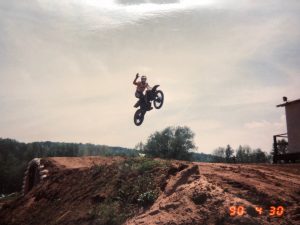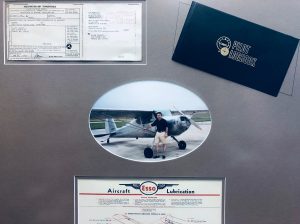Written by Texas Patent Attorney Vincent Allen.
From a farm boy in Mississippi to a big city Texas patent lawyer, this is the story of how I became a patent attorney. I was not one of those like my partner David who knew he wanted to be a patent attorney before he even went to college. No, my journey to becoming a Texas patent attorney had a few stops, but they all helped me develop a unique background that my clients appreciate.
Cars, Dirt Bikes and Aircraft Maintenance School
Like my son Johnny, I had a natural affinity for aviation since before I could remember. Planes flying over always fascinated me. I wanted to be a fighter pilot in the Air Force, but when I realized that I would probably not be able to do that because of the strict medical certification requirements, I decided to attend aircraft maintenance (A&P) school instead.
A&P school was a natural choice for me. Growing up on the farm with old tractors and hay balers, we had no choice but to learn how to repair and maintain the equipment if we were going to get anything done. I became quite good at it. That’s not to say I didn’t break things in the process of trying to do repairs I’d never done before. I still break things, but such is the nature of being self-taught.
Although my dad and my granddad introduced me and provided the resources to repair farm equipment, they were never serious mechanics, leaving the complex for those who did it for a living. I have always had a natural curiosity about how things work, starting with tearing the toaster apart when I was three, and later pulling the bird out of the cuckoo clock. Little did I know that this was the beginning of my training to become an intellectual property lawyer.
My first car was a hand-me-down 1979 Chevrolet Impala that my dad bought new when he was working as a civil engineer on the coast of Mississippi during the construction of I-10. My parents purchased a new car and parked the Impala when it started missing badly.
When I was 15, my dad told me I could have the car if I could get it running. So I took it upon myself to troubleshoot the problem underneath the shade of a large pecan tree in the back yard on our farm outside Purvis, Mississippi. After diagnosing the problem as burnt valves, I pulled the heads off and took them to a repair shop for a valve job.
Gary, the mechanic who helped me with it, was an old friend of my dad’s and we had taken farm equipment to him on occasions when we didn’t have the necessary tools. He gave me a deal on the head job. I put the heads back on, without a torque wrench, mind you—as we did everything by feel on the farm. What a joyous day it was when I turned the key and the V-8 came to life again. My dad couldn’t believe it.
I continued the education with my dirt bikes. As anyone who has had experience with motocross bikes knows, they require heavy maintenance. I’d often stay up to 1 or 2 o’clock in the morning working on the bikes. Whether it was a top overhaul replacing the piston and rings, or replacing the clutch plates, I continued teaching myself about everything mechanical.

1990 on the Honda CR 125
So it was no surprise that I was at the top of my class at A&P school at Bob Jones University in Greenville, South Carolina. While there, we took classes on all aspects of airframe and powerplant maintenance and repair. In addition to the classwork, the FAA requires schools to provide a minimum number of hands-on shop hours to be eligible to take the airframe and power plant license exams.
I enjoyed the electrical and electronics classes that I took so much that I decided that I wanted to go into avionics. But I didn’t give up on my fascination with flight. I purchased a 1946 Cessna 140 while at A&P school, and began restoring it to flying condition.

Graduating A&P School to Southern Mississippi
After graduation from A&P school, I went back home to Mississippi and began working on my engineering pre-requisite classes at Southern Miss. I very much enjoyed theoretical physics and calculus, and was able to easily relate the concepts learned to practical problems in the labs. My physics lab teacher was so impressed with my intuition that he pulled me aside one day and tried to convince me to major in physics. While I was flattered, I knew that I wanted to continue on with the more practical electrical engineering major.
In the meantime, I worked as the only A&P mechanic at Southeast Aviation FBO located at the Bobby Chain Municipal Airport in Hattiesburg, Mississippi. I continued the restoration project on my Cessna 140 in Mississippi. The head of the A&P school at Bob Jones University, who was also a pilot, flew the Cessna 140 down from South Carolina on a ferry permit, and landed it in the field at our farm. He was on the way to Mexico for a mission trip with a group of my classmates. We had a 1200 foot strip with tall pine trees on one end and a clear approach path on the other, making it generally one way in and one way out for the old Cessna.
She didn’t look pretty at first with her flaking white paint, but she was airworthy. In 1992, I began taking flight lessons in the 140 from Mike Delia who ran the Southeast Aviation FBO where I was working as an A&P. Mike flew the Boeing CH-47 Chinook helicopter in the Army National Guard, and taught me to fly with military precision. Mike also instructed me in the FBO’s Piper Pacer, Cessna 150, and Cessna 172 during my initial training.
I will never forget the day that I soloed in the Cessna 140. Although I had already flown the plane many times with an instructor in the right seat, there’s nothing quite like taking up the plane for the first time solo. He told me to do three touch and goes and come back, but I did eight. I didn’t want to stop.
Electrical Engineering at Mississippi State
After my first year at Southern Miss, I transferred to Mississippi State in Starkville, Mississippi to finish my electrical engineering degree. For the first two years that I was at Mississippi State, I scheduled all my classes on Tuesday, Wednesday, and Thursday so that I could continue working in Hattiesburg as an A&P on the weekends. I took my time with flight training, but convinced my instructor to sign me off on a long cross country each weekend so that I could fly the 140 back and forth between Starkville and Hattiesburg, cutting the commute time from 3 hours to 1 ½ hours.
With engineering school and work, I could not find the time to take my checkride to get my pilot’s license until the summer of 1994. With over 100 hours of flight time, 60 hours more than the minimum, I went to take my checkride. My first attempt to take the checkride was with a designated examiner in Hammond, Louisiana. She had ferried bombers during World War II, and my flight instructor liked to use her for his students. When I arrived at the Hammond airport, she gave the airplane a once over and told me she was not going up in it. I couldn’t convince her that it was airworthy. (I told you it wasn’t pretty.) So I flew back to Hattiesburg, sorely disappointed.
Not happy with her rejection of my beloved 140, I decided to take my checkride with an examiner in Laurel, Mississippi. He did not give checkrides in taildraggers, but Mike agreed to let me use one of the FBO’s Cessna 150s. After completing the requisite pre-checkride hours in the 150, I flew to Hesler-Noble Field in Laurel for my checkride. The examiner was impressed with my flying, especially the short and soft-field takeoffs and landings. When you go in and out of a 1200 foot grass strip on the farm as many times as I did in the 140 during initial training, you don’t have much choice but to learn to do that right.
Senior Year at Mississippi State
As I began my senior year at Mississippi State, I started thinking about what was next. I had planned to begin a career in avionics and even interviewed with Lockheed Martin in Marietta, Georgia. Then came the turning point. One of my electrical engineering professors, Dr. Joe Picone, asked me if I would consider going to graduate school in electrical engineering. He wanted me to be one of his graduate assistants and work on research that he was doing in the digital signal processing field. I told him I would think about it.
I did think about it, but like always, I very thoroughly analyzed the situation before reaching a decision. I began doing some research on the internet. Yes, the internet existed then. We didn’t have Google yet, but there were other search engines. I used the Netscape browser to research the career paths available for electrical engineering grads. During the course of this search, I discovered that there was a significant demand for electrical engineers to become patent attorneys.
I never thought I would be an attorney, and in fact, I know that I said at times before this that I would never be an attorney. I had, however, taken a business law class while I was in A&P school at Bob Jones University. I reflected back on how much I had enjoyed that class and reading the case law assignments. So I decided that I would take the LSAT exam and apply for law school shortly before the deadline for entry the following fall.
Dr. Picone was surprised at my announcement that I was applying for law school, and a bit disappointed that I chose not to go to grad school. He was a great mentor though and relayed to me his experience consulting on patent matters. He showed me the first patent I had ever seen.
Law School to Becoming a Texas Patent Attorney
In selecting a law school to attend, I continued my usual careful analysis. Knowing that I wanted to become a patent attorney, I started looking at what opportunities were available. I found that there was only one patent attorney in the whole state of Mississippi at the time, and he was retired. I knew then that I probably needed to go to law school outside Mississippi where there were more opportunities for newly-minted patent attorneys. I always admired Texas and its “everything is bigger in Texas” slogan. The slogan rang true of the number of Texas patent attorneys registered to practice with the USPTO, at least as compared to Mississippi.
After being accepted to Baylor Law, I flew my Cessna 140 to Waco, Texas for a visit. I stayed in the Motel 6 and toured the campus for a day. I was awed by the beautiful campus at Baylor, and the hospitality that was shown me by the faculty and other prospective students while I was there. That visit sealed the deal, and I moved to Waco to start law school in the Fall of 1996, thus beginning my quest to become the first in my family to become an attorney.
I continued flying and began training for my instrument rating in a Piper Warrior that I had purchased and put on leaseback at Southeast Aviation while I was working there. One of my law school classmates and I racked up some hood time flying at night out of the Waco Regional Airport. I took my instrument checkride during my last quarter of law school.
Between my second and third years of law school, I was the first summer clerk at the Dallas, Texas intellectual property law firm, Carstens & Cahoon. I have been at the firm ever since, working my way up from summer associate to now being one of the owners. I have worked in all areas of intellectual property law, from patent and trademark prosecution to complex patent litigation. And because of my love of aviation, I have developed expertise in aviation law, defending manufacturers in aircraft crash cases as well as representing airmen and repair stations in enforcement actions by the FAA.
After twenty years of being a Texas patent attorney, I can honestly look back and say I wouldn’t change a thing. Except, I still need a ride in that fighter jet. Maybe my son Johnny will take me for a ride one day.
Questions About an Aviation or Intellectual Property Law Issue?
If you want to talk about aviation, patents, trademarks, copyrights, or other intellectual property law issues, contact Dallas, Texas patent attorney Vincent Allen at +1-972-367-2001 or send an email to allen@caglaw.com.


